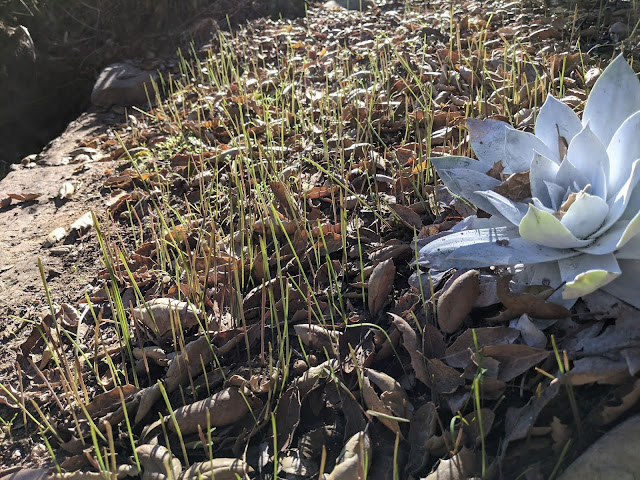Every year at about this time my garden begins to change. It really comes to life in a short period of time. The photo above shows one of the first signs of this change. It is Blue Dicks (Dipterostermon capitatus, formerly Dichelostemma capitatum). This plant grows from a corm that stores energy so that it can put up a shoot immediately after the first rain. I've had these Blue Dicks for 20+ years. Also shown in this photo is a Dudleya pulverulenta.
The annual seeds that I put out a few weeks ago are also sprouting quickly. Here are some Arroyo Lupines (Lupinus succulentus) that still have their cotyledons as well as their adult-type leaves. I just bought a macro lens for my phone/camera which yields much finer detail in closeup photos, such as the hairs on the leaves of the Lupines.
Another plant that is coming back to life now is White-flowered Currant (Ribes indecorum). Like many California plants it is summer-deciduous, so it loses its leaves around June and they come back in fall. Mine is putting out tiny leaves while wild plants are doing the same. The first photo below was taken in my garden on Nov. 7 when I noticed the first green leaves coming out. The second photo was taken on Nov. 17 at Lake Wohlford near Escondido.
Other plants that are summer deciduous include members of the Ocotillo group (Fouquieria genus). In our local deserts we have Fouquieria splendens. In Baja there are two species, and these are the plants I have in my Encinitas garden. The first one (below) is Fouquieria diguetii, known in Baja as Adam's Tree. You can see that it has spines, and the leaves come out at the base of the spines after a sufficient rain. I have it in a container, but I'm pretty sure it has put its roots through the bottom of the pot by now.
A close cousin to Adam's Tree is the truly unique, even bizarre, Boojum Tree (Fouquieria columnaris). In Baja it is known as Cirio which means candle. The thing that makes the Boojum look so strange is the fact that it has a thick trunk at the base, tapering to a slender, rounded point at the top, and it puts out uniformly short, stiff stems all along the trunk. These side stems are completely out of proportion to the size of the trunk. The main trunk sometimes divides into two or more branches at the top. The oddity of its appearance is most evident in really old specimens. First, here are a couple of shots of my Boojum which is in a container. It started putting out leaves a couple of weeks ago.
Below is an older specimen photographed in the Catavina region of Baja.
(c) Tomas Castelazo, 2007, published at WikiCommons
There are other plants in my garden that are starting to wake up, but I'll save those for another day.









No comments:
Post a Comment